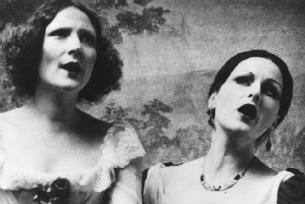KITSCH THROUGH THE CLASSES
Given that kitsch is usually aligned with a lack of awareness, education, urbanity, or sophistication, "low-end" examples are easy to name: the range extends from velvet Elvis paintings to plastic cuckoo clocks. One of its interesting complexities, however, is how kitsch incorporates these sorts of objects as well as those of purportedly refined, upscale "tastes" and socioeconomic prestige, like opera, baroque architecture, and big fountains. Kitsch is an affectation of extremes, upsetting bourgeois tastes by being either too pedestrian or too aristocratic.
Its connection to opera is especially deep, important here since Schroeter's kitsch is unfathomable without it. Of course, opera has lost much of its elite pedigree and prestige, even in Europe. Its insular, protected status is gone—it may still attract the fur coats in Berlin or London, but activists are there to throw blood on them. And as I have shown, critics like Kluge, Clément, and Potter have grown more aware of the blood letting of this particular leisure form.
In contrast to these critics, Schroeter is relatively unconcerned with the deadliness of opera's stories (although only relatively). He gravitates to the materials that convey these stories, opera's exquisite sounds and styles. His soundtracks repeatedly come back to the nineteenth-century world of haut bourgeois Europe, the twilight of late German Romanticism and the beginning of kitsch culture. Critics (most influentially, Corrigan) frequently refer to his film aesthetic as operatic[32] for its stylistic and emotional excesses. Schroeter's use of operas, opera cultures, and especially, diva cultures has led some to argue for "an obvious example of a gay encoding." Ulrike Sieglohr maintains that in his work, "male homosexuality remains a subtext within an aesthetic sensibility and thematic encoding." She quotes Karsten Witte's reference to Schroeter's "homosexual aesthetic," which is achieved through "hidden signs and signals—allusions and secret figures … insisting it is from a gay perspective that one understands [his] encoding as an aesthetic counter-strategy."[33] While I do not agree that these inscriptions codify "gayness," I agree that his work produces a "counterstrategy" that suggests the queer allegory Kuzniar theorized, a disidentificatory appropriation of operatic culture.
In The Death of Maria Malibran, for instance, the opera singer is such a pivotal force that she spills over onto several figures at once. All of the central actors (Magdalena Montezuma, Christine Kaufmann, and Candy Darling) portray the early nineteenth-century diva, who is voiced through recordings or impersonations of twentieth-century divas like Maria Callas and Janis

Schroeter's The Death of Maria Malibran. Courtesy of Museum of Modern Art Film Stills Archives.
Critics have been understandably drawn to comment on Schroeter's high-end kitsch. Gary Indiana contrasts the purported "elitism" of his cultural references with the working-class milieux of Fassbinder films, writing that, "Schroeter's [films] move through the decors of high culture like omnivorous tourists."[34] What Indiana intimates here is that Schroeter's films—and their viewers and listeners—are less of that elite world than visitors, familiar but not identified with it. They are thereby separate from its privilege and power, even if they are still entranced by it. It is another example of disidentification in his work, as opposed to the simpler, resemblance-based forms of identification Sedgwick aligns with camp. This suggests that kitsch can be more generous and "spacious" than Sedgwick maintains, and that Schroeter's "elitism" might have a potentially critical edge.